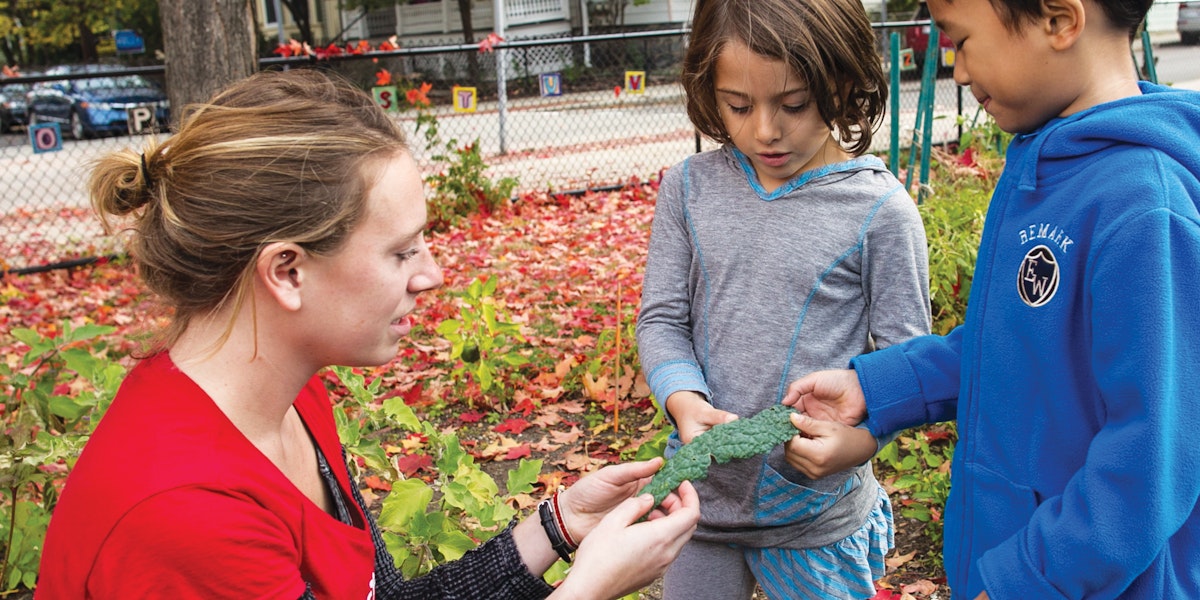The city of Cambridge, Massachusetts is located across the Charles River and just west of Boston. It is a city of more than 110,000 and is home to several select colleges including Harvard University and the Massachusetts Institute of Technology (MIT). According to 2015 Census data, 66.6 percent of residents are white, 11.7 percent of residents are black, 15.1 percent are Asian, 4.3 percent are of two or more races, and 7.6 percent are Latino or Hispanic. The median income is $75,909 and 15 percent of residents are living in poverty.1 The district had a per pupil expenditure rate in 2014 of $27,163—more than almost any other district in the Commonwealth of Massachusetts.2 During the 2015–2016 school year, there were 6,607 students enrolled in the Cambridge Public Schools.3 Among those students, 27.7 percent were economically disadvantaged, 21.6 percent were students with disabilities, and 8.1 percent were English language learners.4 A total of 43 percent of children were eligible for free and reduced-price lunch during the 2014–2015 school year.5
For more than thirty years, Cambridge has worked to promote racial and socioeconomic integration in its schools through a system of district-wide public school choice with a focus on equity.
History of School Integration Efforts in Cambridge
Cambridge is known for its commitment to “controlled choice.” Controlled choice was an approach to school integration largely developed and implemented by student assignment planner and consultant Michael Alves in the 1970s and 1980s after the passage of the Massachusetts’ Racial Imbalance Act. In response to the act, districts such as Boston began to require busing in order to integrate their schools racially. In contrast to approaches based on reassigning students, controlled choice allowed parents to choose schools from across a district while simultaneously giving the district information about the families needed to ensure that schools were balanced racially and/or socioeconomically. Cambridge was the first district in the country to try Alves’s new approach and is still implementing controlled choice today. According to Alves, “Since its adoption in 1981, the Cambridge Controlled Choice Plan has served as a model for many other school districts throughout the United States.”6
The Cambridge Public Schools web site on controlled choice states, “The Controlled Choice Policy is designed to create diverse, academically rigorous schools with equal access to educational resources. Controlled Choice began in 1980 when the Cambridge School Committee voted to desegregate the schools by moving away from a neighborhood schools model.” When the percentage of students who receive “paid lunch” and “free and reduced lunch” matches that of the wider district, the school meets the district’s target and is “balanced.”
When the percentage of students who receive “paid lunch” and “free and reduced lunch” matches that of the wider district, the school meets the district’s target and is “balanced.”
While the Cambridge plan originally focused on racial integration, the district pivoted to a focus on socioeconomic status in 2001 in anticipation of impending court decisions, says James Maloney, chief operating officer of the Cambridge Public Schools. Cambridge did this work proactively and was never under either a court-mandated or voluntary desegregation plan.7 Under this revised socioeconomic controlled choice plan, explained Alves, “When the percentage of students enrolled in a school who receive a “free or reduced lunch” is within 10 percentage points of the district-wide percent free and reduced lunch students, the school is deemed to have met the district’s targeted definition for socioeconomic balance and desegregation.”8 This shift in policy was critical given that, as predicted, the Supreme Court decided in a 2007 case, Parents Involved in Community Schools v. Seattle School District No. 1, that voluntarily adopted choice-based student assignment policies focusing solely on race violated the Equal Protection Clause of the Fourteenth Amendment.
Stories of School Integration
View the profiles of school districts and charter schools pursuing socio-economic integration.The Future of Brown Is Multiracial
How My Family’s Immigration Story Connects to Integration
New York City Public Schools: Small Steps in the Biggest District
Chicago Public Schools: Ensuring Diversity in Selective Enrollment and Magnet Schools
Hartford Public Schools: Striving for Equity through Interdistrict Programs
Stamford Public Schools: From Desegregated Schools to Integrated Classrooms
Dallas Independent School District: Integration as Innovation
Jefferson County Public Schools: From Legal Enforcement to Ongoing Commitment
Eden Prairie Public Schools: Adapting to Demographic Change in the Suburbs
Champaign Schools: Fighting the Opportunity Gap
The Current Plan
The School Committee has updated the controlled choice policy over the years, continuing to seek input from Alves. During the most recent review by the Cambridge School Committee, district administrators, and Alves, the district decided to shift to a three-year average for determining the socioeconomic balance of the city, rather than adjusting the percentages every year. According to Linh O, director of registration for the Cambridge Public Schools, “By taking the three-year average (as of October 1 each year)—this year it was years 2013, 2014, 2015—we have a more accurate representation of the kindergarten SES after school begins for each of those years.”
Under the guidance of O, Cambridge families enroll at the Family Resource Center, which oversees student assignment for the district. When determining a school for a child, the Family Resource Center considers the family’s socioeconomic status, their list of three school choices, and issues related to the specific program—such as preparedness for a dual language program, school size, and the balance of girls and boys in the particular grade. Children who do not gain entry to any of their top three choice schools may stay on the waiting list until the next enrollment period begins.
Impact on Integration and Student Outcomes
Cambridge’s controlled choice program has met many of its goals.
More Integrated Schools
Maloney, who has been chief operating officer of Cambridge Public Schools for twelve years, reports, “While many areas of the country are re-segregating, Cambridge children are less likely than ever before to attend segregated schools.” Figure 19 highlights this trend, showing 57 percent of the Cambridge Public Schools were balanced by race in the 2001–2002 school year, but 73 percent of schools were balanced by race in the 2011–2012 school year. As a result, 84 percent of Cambridge’s students are attending racially balanced schools as compared with the 66 percent who attended racially balanced schools in 2001–2002. Similarly, the schools are far less segregated socioeconomically, with 64 percent of schools being balanced in 2011–2012 as compared to only 36 percent being balanced by SES in 2001–2002. As a result, 67 percent of children were attending socioeconomically balanced schools in 2011–2012, which is up from just 39 percent of students in 2001–2002.10
Strong Student Achievement
While accountability measures have changed during the years that the controlled choice plan has been implemented and revised, Cambridge students do well compared to students in similar districts. In an analysis by the Massachusetts Department of Education, Cambridge students outperformed students in these demographically similar districts, such as Waltham, Somerville and Medford, on the MCAS exam in English, math and science.11 In recent years, the state has focused its accountability measures on a school or district’s “Student Growth Percentile” (SGP). In English Language Arts (ELA), Cambridge is doing better than the state with a SGP of 54 percent versus the state’s SGP of 50 percent. In math, Cambridge and the state have the same SGP of 50 percent.12 Overall, the state rates Cambridge as a Level 2, which is the second highest rating a district can receive.
Many point to the high school graduation rates of Cambridge students of color as a potential measure of success for controlled choice. While Maloney believes many factors contribute to the high graduation rate, such as the city’s wide array of enriching after school activities, he believes controlled choice could be one important factor.13 According to the National Center for Educational Statistics, the most recent data from 2013–2014 show that across the nation, 82 percent of all students and 73 percent of black students graduate from high school. In Cambridge, according to the Massachusetts Department of Education’s most recent data, from the academic year 2014–2015, 91.5 percent of all students, 90.5 percent of black students, 88.7 percent of Hispanic/Latino students, and 89.5 percent of low-income students graduate.

Increased Enrollment
Another potential indicator of the success of school choice in Cambridge is the number of families choosing to send their children to the Cambridge public schools. While competition with private schools is an ongoing issue for the district, enrollment has been increasing for nearly a decade at approximately 2 percent each year, shared Maloney.14
Choices for Parents, and Diverse Experiences for Children
Maloney sees other benefits as well including the fact that all children are able to experience and benefit from the city’s diversity. Finally, parents are not limited to the school in their neighborhoods. They can choose a school on the other side of the city, if they feel the program best matches their child’s needs.15 O sees many benefits as well. She believes, “Controlled choice promotes more diversity in the classroom; it gives children more exposure of different backgrounds and cultures.”16
More Equitable Access to Quality Schools
Another important element of Cambridge’s approach to controlled choice, according to O, is that children who enter the system mid-year still have access to many of the schools because the district reserves some seats in highly selected schools for low-income children who enroll mid-year. In particular, refugee and homeless children—who are more likely to enter mid-year—have more equitable access to all schools as a result.17
Next Steps
Maloney says one of the challenges has been maintaining the Cambridge schools’ unique qualities while simultaneously becoming more accountable to state standards and testing. Prior to the accountability era of the last decade, schools were able to more freely design a creative mission and vision that might attract families from across the city. Another challenge is that, during particular time periods, certain kinds of programs may be more attractive to different parent groups. Currently, the higher socioeconomic parent group is choosing the dual language programs much more than the lower socioeconomic parent group, making it harder to balance those schools.18
Another challenge facing Cambridge, according to Maloney, is that ongoing transfers can be destabilizing for the less frequently chosen schools. Families can transfer once per school year. As each summer ends, spaces open up in the more highly selected schools. Parents then pull their children out of the less frequently chosen schools, making it hard for all educators in the city to plan for the fall.19
In terms of future improvements, O would like to see all of the schools become viable options for families. Maintaining a balance is difficult when families are largely choosing only a subset of schools. “We will have some schools that are chosen by more than 15 percent of that applicant pool and some schools where we have only 2 percent choosing that school. In an ideal controlled choice setting, all the schools would be desirable picks for families and the distribution of picks on the lottery would not be so heavily skewed toward only one third of the schools as top choices,” explains O.20
Cambridge remains a leader in school integration. Administrators’ and educators’ continued commitment to equity and willingness to reflect and improve their policies over time has allowed the district to evolve and to create increasingly diverse learning environments for students.

This profile is part of The Century Foundation’s Stories of School Integration series.
Notes
- “Quickfacts: Cambridge City, Massachusetts,” United States Census Bureau, http://www.census.gov/quickfacts/table/PST045215/2511000/accessible.
- “School and District Profiles,” Massachusetts Department of Elementary and Secondary Education, http://profiles.doe.mass.edu/state_report/ppx.aspx.
- “Information Services – Statistical Reports,” Massachusetts Department of Elementary and Secondary Education, http://www.doe.mass.edu/infoservices/reports/enroll/default.html?yr=1516.
- “School and District Profiles: Cambridge,” Massachusetts Department of Elementary and Secondary Education, http://profiles.doe.mass.edu/profiles/student.aspx?orgcode=00490000&orgtypecode=5&leftNavId=305&.
- “Free and Reduced Price Lunch Enrollment Rates by School District,” Kids Count Data Center, 2016, http://datacenter.kidscount.org/data/tables/7417-free-and-reduced-price-lunch-enrollment-rates-by-school-district?loc=23&loct=10#detailed/10/7634-7636,7638-7658,7660-7664,7666-7677,7679-7701,7703-7748,7750,7752-7764,7766-7779,7781-7786,7788,7790-7826,7828-7832,7834-7835,7837-7838,7840-7841,7843-7858,7860-7861,7863-7871,7873-7881,7883-7886,7888-7911,7914-7916,7918-7928,7932,7934-7940,7942-7951,7953-7970,7972-8024,10015-10016,10033-10034,10036-10038,10040,10043,10047,10224/false/1484,1457,1228,1070,1022/any/14498.
- Michael Alves, phone interview and follow-up email correspondence on August 25, 2016 and September 1, 2016.
- James Maloney, Cambridge Public Schools, Chief Operating Officer, phone interview on July 29, 2016.
- Michael Alves, phone interview and follow-up email correspondence on August 25, 2016 and September 1, 2016.
- “Controlled Choice in Cambridge: A Comprehensive Review & Recommendations,” Submitted to the Sub-Committee of the Whole (Cambridge School Committee) by Co-chairs Fred Fantini and Alice Turkel, May 2013.
- “Controlled Choice in Cambridge: A Comprehensive Review & Recommendations,” Submitted to the Sub-Committee of the Whole (Cambridge School Committee) by Co-chairs Fred Fantini and Alice Turkel, May 2013.
- “School and District Profiles: Cambridge,” Massachusetts Department of Elementary and Secondary Education, http://profiles.doe.mass.edu/profiles/student.aspx?orgcode=00490000&orgtypecode=5&leftNavId=305&; (Dart analysis of demographically similar districts’ MCAS exam scores.)
- “2015 Massachusetts District Report Card Overview: Cambridge Public School District,” NCLB, http://www.cpsd.us/UserFiles/Servers/Server_3042785/File/departments/administration/curriculum_instruction/nclb_report_cards/2014-15/DISTRICT_REPORT_CARD_OVERVIEW.pdf.
- James Maloney, Cambridge Public Schools, Chief Operating Officer, phone interview on July 29, 2016.
- James Maloney, Cambridge Public Schools, Chief Operating Officer, phone interview on July 29, 2016.
- James Maloney, Cambridge Public Schools, Chief Operating Officer, phone interview on July 29, 2016.
- Linh O, Cambridge Public Schools, Director of Registration, interview via email on August 9, 2016.
- Linh O, Cambridge Public Schools, Director of Registration, interview via email on August 9, 2016.
- James Maloney, Cambridge Public Schools, Chief Operating Officer, phone interview on July 29, 2016.
- James Maloney, Cambridge Public Schools, Chief Operating Officer, phone interview on July 29, 2016.
- Linh O, Cambridge Public Schools, Director of Registration, interview via email on August 9, 2016.










